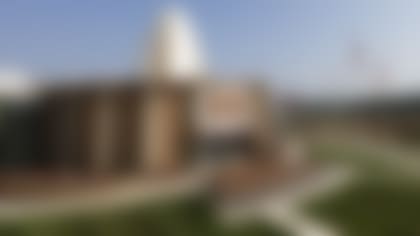Who is your team's top candidate for the Pro Football Hall of Fame?
What a terrifically challenging question to answer. When it comes to who belongs in the museum in Canton -- an Ohio town of less than 100,000 people -- opinions vary, tempers flare and the answer can be difficult to arrive at.
This version of the "All-32" is ambitiously attempting to do just that. Every franchise can boast a player who is arguably worthy of induction right now. Well, everyone but the Texans, who are younger than Christina Aguilera's musical career. Doesn't matter. We cheated for them anyway.
I originally posted this file last summer, but with the Class of 2016 being taken out of circulation when it comes to talk of potential Hall candidates, I found new players to put in the pipeline. I also changed my football mind on more than one team's most deserving man. Of course, the same criteria applied as when I initially compiled this list:
a) It can be a player.
b) It can be a potential Seniors Committee candidate.
c) It can be a "contributor."
One other caveat: The person must be eligible for election in 2017. Which, of course, means guys like Randy Moss, Ed Reed, Peyton Manning and Calvin Johnson weren't considered.
So take a look below, and share your take on any of them ... @HarrisonNFL is the place.
Arizona Cardinals: Kurt Warner, quarterback
Warner is not the only deserving Cardinal out there, especially considering this franchise is the NFL's oldest by far. The former NFL MVP (1999, 2001) is the most deserving, however, when also taking into account his years with the Rams. Yes, Warner's best days were in the Cardinals' former home city (St. Louis), while his 2008 and '09 campaigns in Arizona (when he racked up total of 8,336 passing yards and 56 passing touchdowns, posting a combined passer rating of 95.2 in addition to taking the team to Super Bowl XLIII) represent some of the best quarterback play the organization has seen.
Atlanta Falcons: Mike Kenn, left tackle
Kenn is arguably the best Atlanta Falcon ever. He certainly belongs in the discussion with Claude Humphrey and Deion Sanders, both of whom are in the Hall of Fame but -- unlike Kenn -- spent time on other squads. Kenn competed for 17 years and started in every one of the 251 games he played in, all while wearing a Falcons uniform. He was a five-time Pro Bowler.
Carolina Panthers: Sam Mills, linebacker
You'd be hard-pressed to find anyone who will say a bad word about Mills. He gave his heart and soul to pro football, first in the USFL with the Philadelphia/Baltimore Stars, then in New Orleans from 1986 to 1994, then finally for three seasons in Carolina (1995-97). Everywhere Mills went, his teams won. The Stars captured back-to-back titles. In 1987, with Mills playing a huge part, the Saints made the playoffs for the first time in their 20 years of existence as a franchise. And he was an integral part of the Panthers squad that made the 1996 NFC title game. Mills made the Pro Bowl in five separate seasons, including that '96 campaign at age 37 -- the same year he earned his only first-team All-Pro nod. Former Saints head coach Jim Mora called Mills "the best player I ever coached."
Chicago Bears: Steve McMichael, defensive tackle
"Mongo," as McMichael was affectionately known, was a complete defensive tackle. And much like many others on our top candidates list, he has been completely forgotten about, at least outside of Chicago. There he is loved for being an integral piece of the famed 1985 "46" defense. More importantly, McMichael was the rare interior player who could be a force against the run and pressure the quarterback. If he was facing single blocking, it usually meant he'd win, which is why he posted 95 sacks -- a huge number for a defensive tackle. Warren Sapp was a first-ballot Hall of Famer and had 96.5. Just saying.
Dallas Cowboys: Chuck Howley, linebacker
A number of former Cowboys deserve to be honored in Canton; Cliff Harris and Drew Pearson come to mind immediately. A case can also be made for Ed "Too Tall" Jones, Everson Walls and Darren Woodson. Yet, the most deserving is probably Howley. He might even be the most underrated player in the history of the NFL. A five-time first-team All-Pro, Howley was a big-game player who excelled in coverage and started at outside linebacker until he was 37 years old. He is the only member of a losing team to win the Super Bowl MVP award, for his play in the Cowboys' defeat at the hands of the Baltimore Colts in Super Bowl V.
Detroit Lions: Buddy Parker, coach
The Lions have had many more outstanding players than they're given credit for, especially in relatively recent times. Chris Spielman certainly was a Hall of Very Gooder, as was Al "Bubba" Baker. The most deserving Lion, however, might be Parker, who led the Lions to back-to-back NFL titles in 1952 and '53 while building the roster that won it all again in 1957. This just in: The franchise hasn't won a championship since.
Green Bay Packers: LeRoy Butler, defensive back
I can hear the Jerry Kramer backers from 10 miles away -- no player since Art Monk has had his name argued for so much. Being the author of the most famous block in NFL history has much to do with it (we won't spoil the fun by pointing out that it was a double-team). Given how knowledgeable Packers fans are regarding their franchise, I am genuinely surprised Butler rarely receives mention. Consider:
a) Kramer received five first-team All-Pro nods and three Pro Bowl berths in his career, with (at most) 15 other teams in his league.
b) Butler earned four first-team All-Pro nods and four Pro Bowl berths during his tenure in Green Bay, during a time when the league had between 28 and 30 member clubs. That's nearly twice as much competition as Kramer had.
c) Who do you think started the Lambeau leap?
d) Kramer's Packers already have 12 men enshrined in Canton.
e) Butler's Packers went to two Super Bowls, winning one, while making the postseason seven times during his career. Only one Packer from that era is in the Hall of Fame -- Reggie White -- with another on the way (Class of 2016 member Brett Favre).
Los Angeles Rams: Isaac Bruce, wide receiver
When he played his final season with the Rams in 2007, Bruce was the last member of the 1994 Los Angeles squad still with the team. The current version of the Rams sure could use him now. Bruce earns this nod over Dan Towler, a big back in the 1950s, due to his service to the franchise. Of course, his numbers don't hurt, either. There are very few hominids walking around Planet Earth with over 1,000 career catches who aren't in (or on their way to) the Hall of Fame. Moreover, you could put Bruce's 1995 campaign up against that of any wide receiver ever. That season, with Chris Miller and Mark Rypien -- two QBs well past their prime -- throwing him the football, Bruce put up over 1,700 yards receiving. Think of what DeAndre Hopkins went through with the Texans' revolving door at quarterback last season, then multiply it. And Bruce wasn't playing under rules as forgiving as today's.
Minnesota Vikings: Matt Blair, linebacker
Talk to any longtime Vikings fan, and he/she will extoll the virtues of Blair, an athlete who could seemingly block a kick as easily as he made a tackle. Over his 12-year career in Minnesota, Blair made six straight Pro Bowls at outside linebacker. He was a stalwart on one of the best teams of the 1970s. Even as the Vikes slowly declined in the early '80s, Blair thrived.
New Orleans Saints: Pat Swilling, linebacker
Rickey Jackson is in the Hall of Fame. Sam Mills owns a very strong case, as we laid out in the Panthers' blurb above. We moved Mills to Carolina's slot in this update so that we could include yet another member of the Saints' famed "Dome Patrol" linebacking corps on our list of best Hall of Fame candidates. Swilling posted double-digit sacks in five of his seven seasons in New Orleans, including a whopping 17 in 1991, when he was named Defensive Player of the Year. Only once during Swilling's Saints tenure did the defense fail to rank in the top 10 in points allowed -- in 1989, when they were 11th. Good grief.
New York Giants: George Young, general manager
Among Giants not in the Hall of Fame who could warrant a mention are Phil Simms, Carl Banks and Tiki Barber. Barber's four-year run from 2003 through '06 represents one of the most productive periods, in terms of scrimmage yards, by any running back -- ever. Yet, the vote here goes to a contributor. Without Young, the likelihood of the Giants winning any of their four Super Bowls -- even the two that came long after his tenure with the team ended in 1997 -- is nil, as succinctly put by Mike Vaccaro in this New York Post piece. Young won the NFL Executive of the Year award five times. Five times.
Philadelphia Eagles: Brian Dawkins, safety
With apologies to John Lynch, Steve Atwater and Darren Woodson, there was no better safety in pro football from the late 1990s through the late 2000s. Dawkins patterned his game after Woodson, trying to be the most complete safety possible: stopping the run, making impact plays and, perhaps most importantly, being able to cover. Dawkins was named to nine Pro Bowls during his career, but even more significant was all the team success he enjoyed, including five trips to the NFC Championship Game and one to the Super Bowl.
San Francisco 49ers: Terrell Owens, wide receiver
Owens ranks second all-time in receiving yards (15,934) and third all-time in receiving touchdowns (153) -- so how in the heck did he not make it in his first year of eligibility? As I explained after the Class of 2016 was announced, it seems all receivers -- even the truly transcendent talents -- will have to wait their turn. And this year, Marvin Harrison's number came up first. T.O.'s prime was spent in the Bay Area, from 1996 to 2003, though he didn't become an elite wide receiver until 2000. In case you were wondering, Owens beat out Tim McDonald as the most deserving 49er not in Canton.
Seattle Seahawks: Kenny Easley, safety
His career might have been short, but that doesn't mean it wasn't brilliant. There was not a better safety in pro football in the first half of the 1980s, including Hall of Famer Ronnie Lott (who played mostly corner until 1986). Easley was that rare player who was good out of the gate. A hard hitter, Easley was also a complete player, making five Pro Bowls in seven years before retiring due to injuries.
Tampa Bay Buccaneers: John Lynch, safety
Lynch is simply the best Buccaneer not in the Hall of Fame. Lynch could join Class of 2014 member Derrick Brooks and Class of 2013 member Warren Sapp -- with whom he made up a triumvirate that fortified one of the best defenses of their era -- very soon. Lynch was the hardest-hitting safety in the league in the late 1990s and early 2000s -- and he also had incredible longevity over 15 years. Oh, and he was named to nine Pro Bowls.
Washington Redskins: Jerry Smith, tight end
When NFL Network's "A Football Life: Jerry Smith" came out a couple years ago, viewers around the country were probably saying, "Jerry who?" Smith was never a household name, but he was one of the top five players at his position from his era. His numbers (421 catches, 5,496 receiving yards, 60 receiving touchdowns) are better than those of contemporary -- and Hall of Famer -- Charlie Sanders (336 catches, 4,817 receiving yards and 31 receiving touchdowns). Smith's touchdown total was the most of any tight end in history until 2003, when Shannon Sharpe surpassed him.
Follow Elliot Harrison on Twitter @HarrisonNFL.












